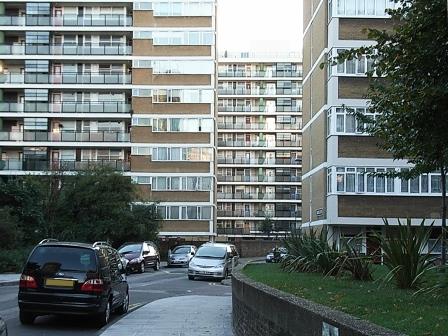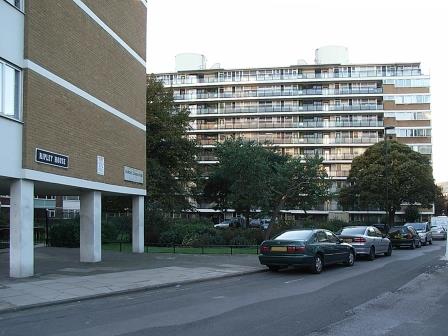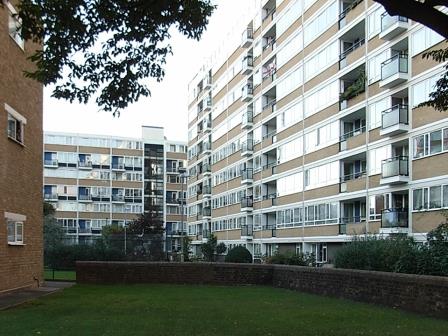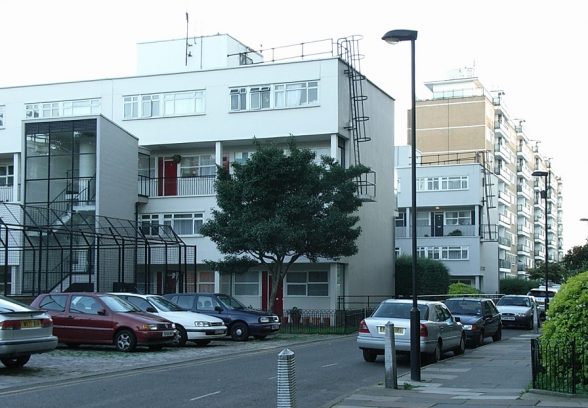This website uses cookies
This website uses cookies to enable it to function properly and to analyse how the website is used. Please click 'Close' to accept and continue using the website.






August 2013 - Churchill Gardens, Pimlico
by Christine Hui Lan Manley
The Churchill Gardens housing scheme by Powell and Moya in Pimlico was built as a result of a prestigious international architectural competition launched following the end of the Second World War. The competition attracted entries from sixty-four architects who put forward proposals for the £4,000,000 housing scheme for Westminster City Council. The thirty-acre site lay on the north bank of the Thames opposite Battersea Power Station; much of the existing terraced housing on the site had been damaged by bombing during the War.
First prize was awarded to young architects Arnold Joseph Philip Powell and John Hidalgo Moya, who designed a scheme along the new planning principle of ‘mixed development.’ Responding to the criticism of the low-density unplanned suburban housing of the inter-war period, Powell and Moya designed buildings to a variety of heights, ranging from eleven-storey blocks to three- and four-storey houses and maisonettes. This ensured visual variety to counter the monotony of the earlier suburbs. In addition, it would attract a broad cross section of residents which was in accordance with the post-war ambitions of creating socially-balanced classless communities. As well as housing, Powell and Moya incorporated many social amenities within the scheme, including shops along Lupus Street, three schools, a number of play areas and a community centre.
The scheme was built to a high density of over 200 people per acre, and at the time of construction it was the largest urban area to be rebuilt according to the plan of a single firm of architects. The low three-storey terraced houses are located along the southern edge of the site which borders the Thames, while the taller blocks – ranging from nine to eleven storeys – are positioned perpendicular rather than parallel to the river. This layout maximises the number of dwellings with a river view. The central thoroughfare, Churchill Gardens Road, is gently curving which has a softening effect on the overall layout. This was in contrast to the second, third and fourth prize winning schemes, which all adopted rigid axial plans. Furthermore, Powell and Moya’s layout might at first evoke visions of rational scientific Zeilenbau site planning (building in rows), however, the slight irregularity in the positioning of the blocks along the curved road softens the layout further. The relationship of the buildings to the curved road creates a sense of enclosure to the street scene. In some cases, the ground floor level is set back from the road, allowing views through to the landscaped courtyards, which are carefully integrated with the buildings.
In the 1953 September edition of the Architectural Review (AR), Henry-Russell Hitchcock declared that Powell and Moya had clearly dealt with the major problem of twentieth century group planning: the architects had been ‘formally architectonic’ when organising the large related structures, without relying on the old devices of axial symmetry. In this sense, the scheme was distinctly modern; the layout purposely avoided planning techniques from the past. Hitchcock drew parallels between Le Corbusier’s Unité d’Habitation at Marseilles and Powell and Moya’s Churchill Gardens. Firstly, he noted the use of colour was similar, secondly, the four-storey maisonettes, to Hitchcock, seemed ‘Corbusian.’ Retrospectively, the two housing schemes are very different. Powell and Moya’s Pimlico housing could be described as a soft, ‘humanised’ version of the earlier modernist architecture and planning, rather than the ‘hard’ modernism which Le Corbusier’s work typified. At Churchill Gardens, Powell and Moya have demonstrated a deep concern for the visual qualities of the spaces created between the buildings. In order to humanise the urban environment, they opted for panels of traditional brick rather than exposed concrete for the tall blocks. Furthermore, despite the scale of the blocks, they have succeeded in creating small intimate landscaped spaces, to further humanise the total environment.
The Churchill Gardens housing scheme was a pioneering example of post-war mixed development in Britain. Its success was celebrated in 1951, as the first five buildings on the site received a Festival of Britain Award. Today, these same buildings – which comprise four nine-storey blocks and a circular glazed accumulator tower which stored excess heat from Battersea Power Station – are Grade II listed. At Churchill Gardens, Powell and Moya demonstrated an outstanding example of how the ‘new architecture’ of the inter-war period could be adapted to create a softer, ‘humanised’ version of modern architecture and urban planning.
Christine Hui Lan Manley is currently completing a PhD in Architectural History at the Mackintosh School of Architecture. Her research centres on the concept of urbanity, and in particular, Sir Frederick Gibberd’s interpretation of the concept and his application of the idea to housing design at Harlow New Town.
Look for past Buildings of the Month by entering the name of an individual building or architect or browsing the drop down list.

Become a C20 member today and help save our modern design heritage.